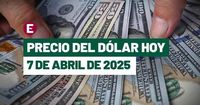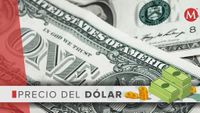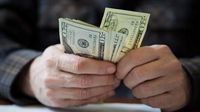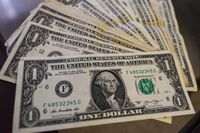On Monday, April 7, 2025, the dollar price showed a robust rebound in international markets, reaching 20.65 pesos per unit, which marks a 1.19% increase compared to the previous close. This surge occurred during a day characterized by a new "Black Monday" in global stock markets, triggered by the recent tariff policies of U.S. President Donald Trump. The dollar opened the day at 20.40 pesos, fluctuating between 20.47 and 20.80 pesos amid a growing demand for safe-haven assets in light of global financial volatility.
Year-to-date, the exchange rate has demonstrated a significant variation of 25.55%, according to Forex market data. This strengthening of the dollar coincides with a historic decline in international stock markets, as Trump’s protectionist measures—imposing tariffs of up to 50% on imports—have ignited a trade war with China. In retaliation, China has retaliated with tariffs of up to 34% and threats of restricting trade in rare earth materials, creating a domino effect that has rattled markets across Asia, Europe, and the United States.
The most affected indices included Hong Kong's Hang Seng, which plummeted by 13.2%, Japan's Nikkei, which fell by 7.8%, and Taiwan's market, which recorded its worst day in history with a 9.57% loss. In Europe, the Milan stock exchange decreased by 6.7%, while Paris and Frankfurt saw declines of 6.3% and 6.19%, respectively. Meanwhile, on Wall Street, the Dow Jones and the S&P 500 had already faced drops of 5.5% and 6% the previous Friday.
The dollar price in Mexico on April 7, 2025, varied across different banks and exchange houses. For instance, Afirme bought the dollar at 19.60 pesos and sold it at 21.30 pesos, while Banco Azteca bought at 19.65 and sold at 21.00 pesos. Bank of America reported a buy rate of 19.685 and a sell rate of 21.978 pesos. Banorte acquired the dollar at 19.20 and offered it at 20.75 pesos, whereas BBVA Bancomer bought at 19.80 and sold at 20.94 pesos. CiBanco noted the dollar price at 20.70 pesos, and Banamex had a buy rate of 20.02 and a sell rate of 21.18 pesos.
As the day progressed, the peso began to show signs of weakness, starting the day with losses due to fears of a global recession. The dollar opened at 20.69 units per dollar, marking a loss of about 1.35% compared to the reference price from the previous Friday, which recorded its worst percentage fall since June of last year. Monex Grupo Financiero indicated that investors remained vigilant regarding potential negotiations over reciprocal tariffs while the likelihood of a global economic recession loomed larger.
In the early hours of April 7, the peso weakened to 20.80 units, a level not seen since early March. The dollar’s performance was not limited to the Mexican peso; it also fell 0.41% against the Japanese yen, trading at 146.255 yen, following a drop of more than 1.4% in the previous session. The dollar also reached its lowest level in six months against the Swiss franc, down 0.7% to 0.8545 dollars.
Investors fled to safe-haven assets such as the dollar, yen, and Swiss franc as global markets continued to decline. The widespread tariffs imposed by Trump have raised fears of a deep recession, prompting speculation that the U.S. Federal Reserve might cut interest rates as early as May. Reports indicated that more than 50 nations had contacted the White House to initiate trade discussions with the United States, highlighting the global ramifications of the ongoing tariff disputes.
In Mexico, the dollar's price on April 7, 2025, was quoted at 20.70 pesos, with the previous closing price being 20.46 pesos. Some banks offered the dollar for sale at prices as high as 21.80 pesos, while the buying prices varied significantly. For example, Scotiabank had the dollar at 18.00 pesos for purchase and 21.80 pesos for sale, illustrating the diverse rates across financial institutions.
As the peso faced its second consecutive session of depreciation, accumulating a total fall of 86.1 cents or 4.32%, analysts warned that if the trend continued, the peso could reach 21 per dollar. This situation underscores the critical impact of the trade war on the Mexican economy, with many investors and financial analysts expressing concern about the potential for further declines.
In summary, the dollar's rebound and the peso's depreciation reflect the ongoing uncertainties in the global economic landscape, particularly influenced by the trade policies of the U.S. government. As markets react to these developments, both investors and consumers alike are urged to stay informed and cautious in their financial dealings.









